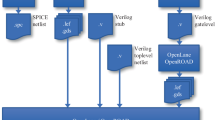Abstract
Traditional methods for system-level design of Delta–Sigma (∆Σ) modulators typically assume linear modeling of the modulator, in which quantization noise is modeled as additive independent white noise. But it is well known that the ∆Σ modulator is a non-linear system and linear modeling is only an approximation. Also, circuit-level non-idealities, which may greatly change the modulator behavior, are typically neglected at system-level design. As a result, system-level modulator designs obtained from traditional methods may not be realistically optimal. This paper presents a system-level post-optimization method for ∆Σ modulators so that modulator designs initially obtained from traditional methods are post-optimized considering non-linear and non-ideal characteristics of ∆Σ modulators including both quantization noise and circuit-level non-idealities. The post-optimization algorithm is based on Finite Difference Stochastic Approximation due to the stochastic nature of modeling of some circuit-level non-idealities in system-level design. During the post-optimization run, each candidate design is simulated for performance measures and stability has always been a must constraint. Results on two ∆Σ modulators have shown that post-optimized modulator designs outperform the original designs from traditional methods.








Similar content being viewed by others
References
Veldhoven, R. (2003). A triple-mode continuous-time Delta–Sigma modulator with switched-capacitor feedback DAC for a GSMEDGE/CDMA2000/UMTS receiver. IEEE Journal of Solid-State Circuits, 38(12), 2069–2076.
Norsworthy, S., Schreier, R., & Temes, G. (1996). Delta–sigma data converters: theory, design, and simulation. New York: IEEE Press.
Schreier, R. (1993). An empirical study of high-order single-bit Delta–Sigma modulators. IEEE Transactions on Circuits and Systems II, 40(8), 461–466.
Zhong, L., & Jha, N. (2005). Interconnect-aware low-power high-level synthesis. IEEE Transactions on CAD of Integrated Circuits and Systems, 24(3), 336–351.
Hanchate, N., & Ranganathan, N. (2006). Post-layout gate sizing for interconnect delay and crosstalk noise optimization. In Proceedings of International Symposium on Quality Electronic Design
Vancorenland, P., Plas, G., Steyaert, M., Gielen, G., & Sansen, W. (2001). A layout-aware synthesis methodology for RF circuits. In Proceedings of International Conference on Computer Aided Design.
Bajdechi, O., Gielen, G., & Huijsing, J. (2004). Systematic design exploration of Delta–Sigma ADCs. IEEE Transactions Circuits and Systems I, 51(1), 86–95.
Schreier, R. (2004). The Delta–Sigma Toolbox 6.0. http://www.mathworks.com/matlabcentral/fileexchange.
Cherry, J. & Snelgrove, W. (2002). Continuous-time delta–sigma modulators for high-speed a/d conversion. Berlin: Kluwer Academic Publishers.
Loeda, S., Martin, H., & Mulgrew, B. (2006). On the design of higher-performance wide-band continuous-time sigma-delta converters using numerical optimization. IEEE Transactions on Circuits and Systems I, 53(4), 802–810.
Cherry, J., & Snelgrove, W. (1999). Clock jitter and quantizer metastability in continuous-time delta-sigma modulators. 676, 46(6), 661–676.
Malcovati, P., Brigati, S., Francesconi, F., Maloberti, F., Cusinato, P., & Baschirotto, A. (2003). Modeling sigma-delta modulator non-idealities in simulink. IEEE Transaction on Circuit and Systems I, 50(3), 352–364.
Ruiz, J., Rosa, J., Medeiro, F., Fernandez, F., Rio, R., Perez, R., & Rodriguez, A. (2005). High-level synthesis of switched-capacitor, switched-current and continuous-time Sigma-Delta modulators using SIMULINK-based time-domain behavioral models. IEEE Transactions on Circuits and System I, 52(9), 1795–1810.
Spall, J. (2003). Introduction to stochastic search and optimization: Estimation simulation and control. Hoboken: Wiley.
Robbins, H., & Monro, S. (1951). A stochastic approximation method. Annals of Mathematical Statistics, 22(1951), 400–407.
MATLAB. (2012). MATLAB 2012Ra. The MathWorks Inc.
Cadence. (2005). Analog Design Environment User Guide. The Cadence Inc.
IBM. (2004). IBM CMRF7SF Model User Guide. IBM Corporation.
Author information
Authors and Affiliations
Corresponding author
Rights and permissions
About this article
Cite this article
Tang, H. System-level post-optimization of Delta–Sigma modulators using finite difference stochastic approximation. Analog Integr Circ Sig Process 88, 31–42 (2016). https://doi.org/10.1007/s10470-016-0729-x
Received:
Revised:
Accepted:
Published:
Issue Date:
DOI: https://doi.org/10.1007/s10470-016-0729-x




